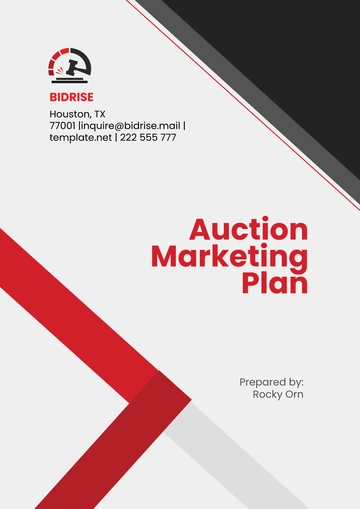Free Annual Nonprofit Marketing Plan

Prepared by: [YOUR NAME]
Company: [YOUR COMPANY NAME]
Address: [YOUR COMPANY ADDRESS]
Website: [YOUR COMPANY WEBSITE]
I. Executive Summary
This document outlines [Your Company Name]'s annual marketing plan, aiming to elevate awareness, funds, and support for the organization. By focusing on storytelling, community engagement, and partnerships, we aim to maximize impact while remaining aligned with our mission.
II. Situation Analysis
A. Organizational Overview
[Your Company Name] is a global humanitarian organization dedicated to providing emergency assistance, disaster relief, and education. Our mission is to alleviate human suffering in times of crisis by mobilizing the power of volunteers and the generosity of donors worldwide.
Challenges include increasing competition in the nonprofit sector and the need to adapt to changing donor preferences and technological advancements. However, our strong brand recognition and dedicated volunteer base position us well to overcome these challenges.
B. Market Analysis
SWOT Analysis:
Strengths: Strong brand recognition, dedicated volunteer base, global presence. | Weaknesses: Limited funding sources, bureaucratic processes, reliance on external support. |
Opportunities: Growing public awareness of humanitarian issues, potential for digital innovation, expanding partnerships. | Threats: Economic downturns, donor fatigue, political instability in regions of operation. |
The competition includes other humanitarian organizations, local charities, and crowdfunding platforms. However, our longstanding history and track record of impactful work differentiates us in the market.
III. Target Audience & Personas
A. Primary Audience
Demographics:
Age: 25-54
Gender: Primarily female
Income: Middle to upper-middle class
Psychographics: Compassionate, socially conscious, active in community involvement.
Behaviors: Regular donors, volunteers, active on social media platforms.
Persona: Meet Sarah: At 35, she's a working professional with a passion for humanitarian causes. Sarah regularly donates to [Your Company Name] and volunteers at local events, driven by her desire to make a meaningful difference in the world.
B. Secondary Audience
Students: High school and college students interested in volunteer opportunities and social impact.
Corporations: Businesses looking to engage in corporate social responsibility initiatives and support causes aligned with their values.
IV. Goals & Objectives
A. Overall Goals
Increase fundraising revenue by 20% to support our ongoing humanitarian efforts.
Raise awareness of [Your Company Name]'s mission and impact by reaching 1 million new supporters worldwide.
Recruit 5,000 new volunteers to support our programs and initiatives, strengthening our capacity to respond to emergencies and disasters.
B. Objectives
Secure $1 million in donations through a year-long fundraising campaign, leveraging various channels and donor engagement strategies.
Host 100 community events across our global network to engage with local communities, share our stories, and recruit volunteers.
Forge strategic partnerships with 10 corporations for joint fundraising and volunteering initiatives, amplifying our impact and reach.
V. Strategies & Tactics
A. Storytelling
Develop emotionally compelling video testimonials from beneficiaries and volunteers to showcase the tangible impact of our work.
Launch a blog series featuring personal stories of resilience and hope from individuals who have been helped by [Your Company Name], aiming to inspire empathy and action.
B. Community Engagement
Organize and promote local blood drives, disaster preparedness workshops, and first aid training sessions, fostering community resilience and preparedness.
Launch a social media campaign encouraging supporters to share their volunteering experiences using a branded hashtag, fostering a sense of belonging and camaraderie within our community.
C. Partnership Development
Identify and cultivate strategic partnerships with local businesses, schools, and community organizations for cause-related marketing campaigns and joint fundraising events.
Collaborate with schools and universities to engage students in volunteer opportunities, educational programs, and advocacy initiatives, nurturing the next generation of humanitarian leaders.
VI. Implementation Plan
A. Timeline
Timeline | Activities |
|---|---|
January-March | Fundraising campaign planning and kickoff |
April-June | Community events and volunteer recruitment drives |
July-September | Corporate partnership development and activation |
October-December | Year-end giving campaign and impact reporting |
B. Responsibilities
Marketing Team: Content creation, campaign execution, and social media management, ensuring consistent messaging and branding across all channels.
Volunteer Coordinator: Volunteer recruitment, training, and coordination, providing support and resources to volunteers to ensure a positive experience.
Development Team: Donor stewardship, fundraising events, and corporate partnerships, cultivating relationships with donors and partners to secure financial support and strategic collaborations.
C. Budget Allocation
Category | Allocation |
|---|---|
Marketing Materials | $50,000 |
Event Expenses | $100,000 |
Digital Advertising | $75,000 |
Volunteer Support | $25,000 |
Corporate Partnership Activation | $50,000 |
VII. Monitoring & Evaluation
A. Key Performance Indicators (KPIs)
Total funds raised
Number of new supporters acquired
Volunteer engagement metrics (e.g., hours volunteered, retention rates)
B. Evaluation
Conduct monthly review meetings to assess progress against KPIs, identify areas for improvement, and make data-driven decisions to optimize performance.
Prepare an annual report highlighting achievements, challenges, and lessons learned, providing transparency to stakeholders and demonstrating the impact of their support.
- 100% Customizable, free editor
- Access 1 Million+ Templates, photo’s & graphics
- Download or share as a template
- Click and replace photos, graphics, text, backgrounds
- Resize, crop, AI write & more
- Access advanced editor
Enhance and Discover the Annual Nonprofit Marketing Plan Template from Template.net. Crafted for impact, it's a dynamic tool for strategic visionaries. With its editable and customizable features, tailored campaigns are effortless. Transform your outreach game seamlessly with this template, editable in our cutting-edge Ai Editor Tool. Elevate your nonprofit's reach today.





























